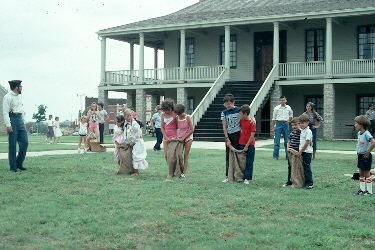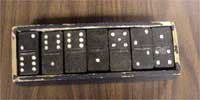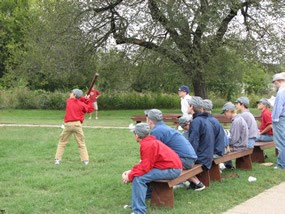
In the 1840s, there were no television sets, stereos, or video games, but there were always enough people around for playing games. Families were large; parents and several children, as well as an aunt, uncle, or a grandparent or two, lived under one roof. Children also played games at school, in the village, and at work parties.
Playing in the parlor
People who owned large homes often had a parlor. A parlor was a special room that was used for entertaining guests. When families invited neighbors to visit, they played games in their "best room." These games were known as parlor games. Parlor games often involved several people. Charades and Blind Man's Buff were popular parlor games. Guessing games, word games, and board games were also played in the parlor. 
Table games
Some table games required a steady hand or quick wit to win. In other games, victory depended on the luck of the draw.
Dominoes - Playing dominoes was a favorite pastime the late 1800s. The game is still played today. Dominoes are flat, rectangular blocks called tiles or bones. Each tile has two groups of dots on one side. The dots range in number from zero to six. Tiles with the same number both ends are called doublets. One dominoes game is called Draw. The tiles are put in the middle of the table, face down. Each player draws three tiles and looks at them. The rest of the dominoes are left face down in the "bone yard." Whoever has the doublet with the most dots lays it on the table. The second player puts a domino with a matching number of dots against the doublet. Doublets are put down sideways, as shown on the left. The next player must lay a match at the free end of a tile. If he or she cannot, the player must turn over new dominoes until a match is found. The first player to lay down all of his or her dominoes wins.
Tiddlywinks - Almost everyone has heard of tiddlywinks, but few people know how this game is actually played. Players use a disk called a shooter to flip smaller disks called winks into a cup that sits in the middle of the playing area. The object of the game is to be the first player to sink all of his or her disks into the cup. In the past, players took this game very seriously and practiced flipping winks in their spare time.
Pickup sticks - Pickup sticks, or jackstraws, was a very popular game among North American settlers. The game originated with American Indians. It was originally played with straws of wheat. To play, all that was needed was a pile of wood splinters or straws. Some fancy pick-up-stick games had ivory straws. Modern versions of jackstraws use wooden or plastic sticks. The sticks are heaped in the middle of a table. Each player takes a turn removing one stick from the pile. The challenge is to do so without moving any of the other sticks.
Cards - In the early 1800s, most children's card games were designed to be educational. Card games helped children learn about math, geography, history and science. Some card games even taught girls about cooking. Board games
Chess, checkers, and backgammon have been pastimes for older children and adults for hundreds of years. In the 1800s, new board games became popular. They were designed to be played by the entire family.
Teetotum - When people played board games in settler times, they did not use dice because dice were associated with gambling. Instead they used a teetotum, a top with numbers along the side. When the teetotum stopped spinning and fell on its side, the number facing up was the number of moves the player was allowed to make.
Morality games - Board games had themes that were supposed to improve children's minds. For example, in Snakes and Ladders, the ladder squares had pictures of children doing good deeds. When a player landed on one of these squares, he or she moved several spaces ahead. The snake squares had pictures of children being disobedient. The player who landed on one of these was sent back several squares.
Educational games - Some board games were educational. They drilled players on subjects like science, literature, and history. Some of the most popular games, such as Round the World and Geographical Lotto, taught geography skills. Games such as Picture Lotto and Familiar Objects were designed to teach younger children words and objects. The World's Educator was a challenging game for older players. 
Outdoor games
Annie Over - This game needed two teams, a ball, and some kind of barrier, like a log or a table, or possibly low wall. Teams stood on either side of the barrier. The team with the ball was "it." They yelled "Annie!" and throw the ball to a member of the opposing team. If the child didn't catch the ball, then that team was "it." If he or she catches the ball, the teams have to change sides fast. While the teams are running to change sides, the one who caught the ball tries to hit an opponent with the ball. If he or she succeeds, the child who was hit changes teams. The goal is to eliminate the other team.
Baseball - Baseball as a formalized sport was just gaining popularity in the 1840s. It originated with the British games of cricket and rounders. There were many American versions of "Base Ball," with just as many different rules played by children in their villages, soldiers fighting in the Civil War, slave children in the South, and many others. The first formalized rules for the game were introduced in 1845 in New York. The game probably would have been played by the soldiers at Fort Scott, but the formalized rules would probably not have been followed until the late 1840s or early 1850s.

Graces - The game of graces was played by two players, either two girls or a girl and a boy. Boys did not play Graces with one another because it was considered a "girl's game." Each player had a stick. Using the sticks, the players tossed a hoop to one another. The game was meant to encourage children to move gracefully.
The information on this page was primarily taken from Games from Long Ago written by Bobbie Kalman published by Crabtree Publishing Company. Used by permission.
The information on baseball came from the site baseballhistory.com
The information on the game Annie Over was taken from an article which appeared on the Christian Science Monitor's website. The article, dated February 24, 1998, is titled What Kids Did on The Western Frontier by Kristina Lanier. Used by permission. In this article the author refers to the game as Anthony Over, but the more common name of the game was Annie Over. Copyright © 1998 The Christian Science Monitor. All rights reserved. Online at csmonitor.com. |
Last updated: May 25, 2022

